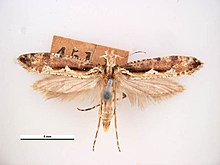| Rhigognostis annulatella | |
|---|---|

| |
|
Scientific classification
| |
| Domain: | Eukaryota |
| Kingdom: | Animalia |
| Phylum: | Arthropoda |
| Class: | Insecta |
| Order: | Lepidoptera |
| Family: | Plutellidae |
| Genus: | Rhigognostis |
| Species: | R. annulatella
|
| Binomial name | |
| Rhigognostis annulatella (
Curtis, 1832)
| |
| Synonyms | |
| |
Rhigognostis annulatella (ringed diamond-back or annulated smudge) is a moth of the family Plutellidae. It is found in most of Europe.

The wingspan is about 18 mm. The head is whitish, with some dark fuscous hairs. Tuft of palpi very short. Forewings light fuscous, much suffused with whitish - ochreous, with scattered dark fuscous strigulae; an ochreous-whitish dorsal streak from base to tornus, upper edge with triangular projections before and beyond middle, towards base blackish-edged. Hindwings are light grey. The larva is green; spots black, conspicuous; head and 2 black-speckled. [1]
Adults are on wing from July onwards, and overwinter in this stage, occurring on the wing until April.
The larvae feed on Cochlearia officinalis.
References
-
^ Meyrick, E., 1895 A Handbook of British Lepidoptera MacMillan, London
pdf
 This article incorporates text from this source, which is in the
public domain. Keys and description
This article incorporates text from this source, which is in the
public domain. Keys and description
External links
| Rhigognostis annulatella | |
|---|---|

| |
|
Scientific classification
| |
| Domain: | Eukaryota |
| Kingdom: | Animalia |
| Phylum: | Arthropoda |
| Class: | Insecta |
| Order: | Lepidoptera |
| Family: | Plutellidae |
| Genus: | Rhigognostis |
| Species: | R. annulatella
|
| Binomial name | |
| Rhigognostis annulatella (
Curtis, 1832)
| |
| Synonyms | |
| |
Rhigognostis annulatella (ringed diamond-back or annulated smudge) is a moth of the family Plutellidae. It is found in most of Europe.

The wingspan is about 18 mm. The head is whitish, with some dark fuscous hairs. Tuft of palpi very short. Forewings light fuscous, much suffused with whitish - ochreous, with scattered dark fuscous strigulae; an ochreous-whitish dorsal streak from base to tornus, upper edge with triangular projections before and beyond middle, towards base blackish-edged. Hindwings are light grey. The larva is green; spots black, conspicuous; head and 2 black-speckled. [1]
Adults are on wing from July onwards, and overwinter in this stage, occurring on the wing until April.
The larvae feed on Cochlearia officinalis.
References
-
^ Meyrick, E., 1895 A Handbook of British Lepidoptera MacMillan, London
pdf
 This article incorporates text from this source, which is in the
public domain. Keys and description
This article incorporates text from this source, which is in the
public domain. Keys and description
External links